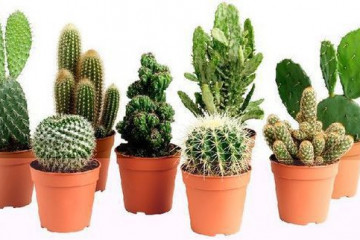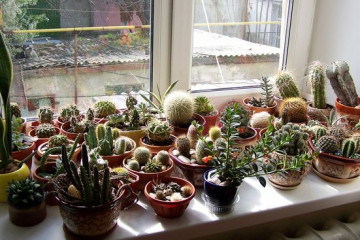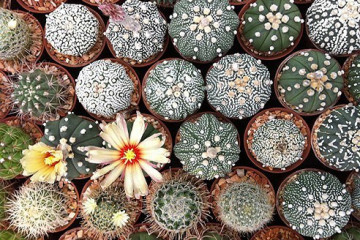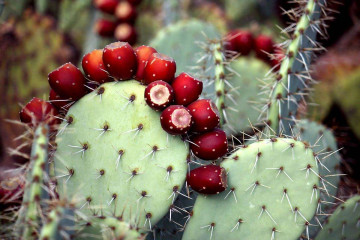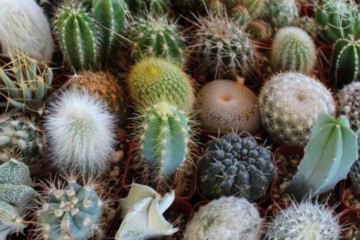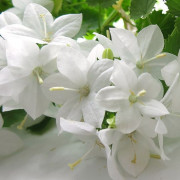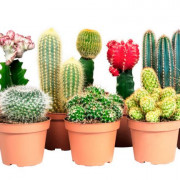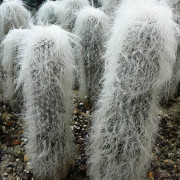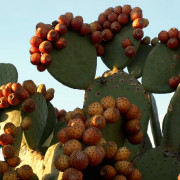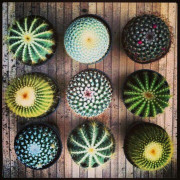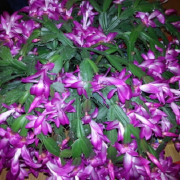Opuntia cactus - varieties, home care
Content:
The homeland of prickly pears are semi-deserts and mountain slopes of North and South America, from where the cactus was distributed in tropical and subtropical zones around the world. It is depicted on the national emblem and is one of the national symbols of Mexico. This culture blooms beautifully and does not require careful maintenance.
What is prickly pear: characteristics and common varieties
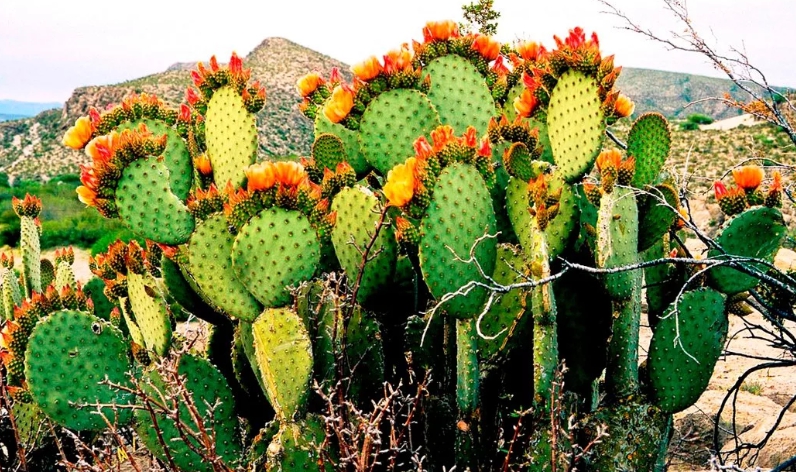
Opuntia in natural conditions
Opuntia is a perennial evergreen cactus of the Cactus family, which includes several hundred species: from small creepers to large bushes and trees (Cactus Opuntia). This is a rare species of cactus that can winter in the open field even in a temperate climate, in a not too hot summer and short-term frosts up to 10 degrees. Surprisingly, such a tropical plant as prickly pear, both in heat and cold, feels great, successfully flowers and bears fruit.
Edible prickly pear is highly valued for the fruit with a high content of vitamin C. Such varieties of cactus are grown in some countries for the production of jams, preserves, juices, and wine. Carmine dye is obtained from prickly pear. An unpretentious plant sometimes grows in the most inappropriate conditions: on rocks, cliffs, slopes.
Shoots of culture are fleshy and juicy, creeping, standing, or in the form of trees. They are equipped with thorns and glochidia, which make it more difficult to care for a cactus.

Glochidia prickly pear
The main varieties of prickly pear:
- Common prickly pear. Reaches two meters in height, with yellowish glochidia and golden yellow flowers up to 7 cm in diameter.
- The prickly pear is cylindrical. It has cylindrical branches, flowers of pastel colors, often half-closed.
- Main (main). Bushy cactus with long stems, flowers ranging from pink to red.
- Berger's prickly pear. Grows above 1 meter. It has bright green shoots up to 25 cm, abundantly growing orange-yellow inflorescences.
- Gosselin. Bushy cactus with bright yellow inflorescences, multicolored greenish-gray-blue leaves. The spines are about 10 cm long, but soft, located on the tops of the leaves.
- Opuntia microdasis (otherwise prickly pear). A culture with bright sunny inflorescences and needles, large scarlet fruits.
- Opuntia Subulata. Has glochidia at the junction of leaves with a trunk, scarlet inflorescences.
- Fig (Indian). Reaches a height of 4 meters. It has olive leaves, bright orange flowers and fruits up to 8 cm.
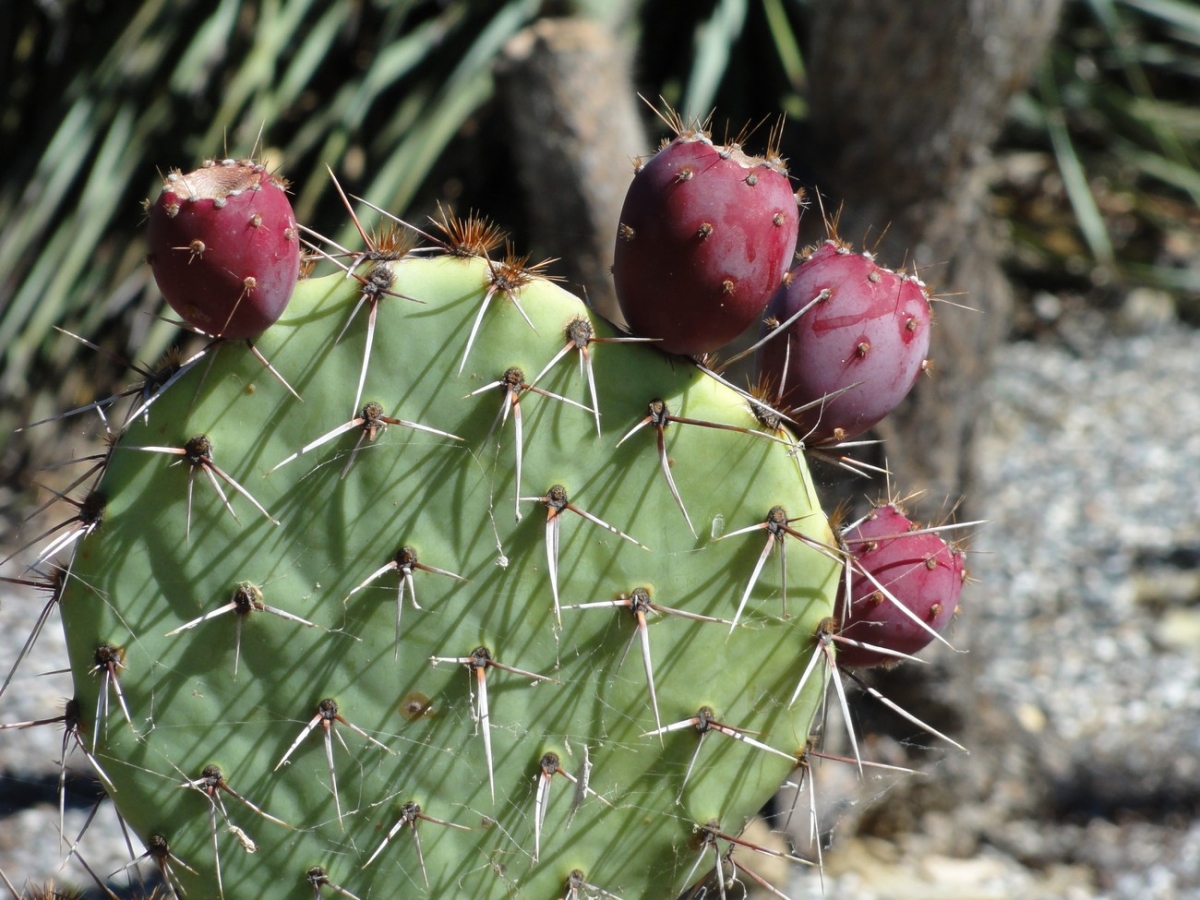
Opuntia fig (Indian)
- Opuntia monacanth variegat. It resembles sea coral with light red spines.
- Imbricate. It has hard shoots, chocolate-colored thorns 3 cm, purple inflorescences up to 8 cm in diameter, bush height up to 25 cm.
- Brazilian prickly pear. Woody species up to 20 meters high. On one plant, steles of different shapes, inflorescences of a yellow hue.
- Darwin. Does not grow above 10 cm, has yellow-brown inflorescences up to 4 cm in size.
- Polyacanthus. Possesses large yellow flowers.
- Opuntia Theokant. It grows up to 20 cm, blooms with yellow flowers up to 8 cm in diameter.
- Opuntia Fragilis.Miniature variety with 3 cm inflorescences.
Home care for prickly pear cactus
Opuntia loves care close to its natural habitat, which includes:
- Well lit place, protected from direct sunlight and drafts. South windows are optimal.
- In summer, depending on the variety of culture, warm room temperatures.
- In winter, it is minimally humid, low temperatures up to 5-7 degrees, so that the plant does not grow out.
- Prevention of moisture accumulation in the soil, good drainage and permeability of the soil.
- Weakly acidic with 4.5-6 pH, nutritious without humus, loose soil from a mixture of leafy, turfy soil with gravel (sand), expanded clay. To maintain looseness, to prevent compaction of the soil, it is better to water in a sump.
- Regular moderate watering for succulents in spring and summer, especially on hot days, which gradually decrease by autumn, stop in winter. Soft water, acidified with a few drops of lemon, should not fall on leaves and inflorescences.
- In the spring and summer, once every 2-4 weeks, top dressing is applied based on complex mineral fertilizers for cacti, with a low nitrogen content. Closer to autumn, fertilizing is reduced, in winter it does not need to be fertilized at all.
- Humidity does not significantly affect development. Spraying is not required neither in summer heat, nor in winter when heating devices are operating.
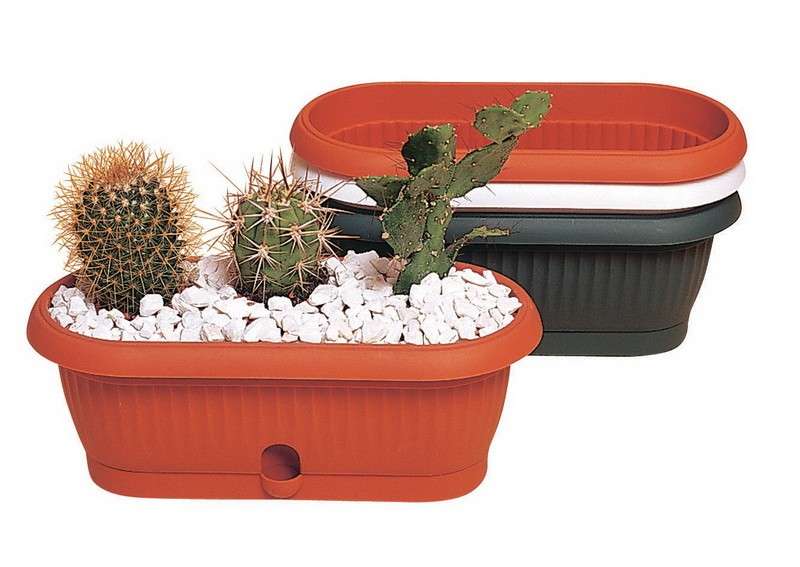
The container for the cactus should be shallow and wide, because the roots are not very developed
Features of care in winter, during the rest period
The dormant period lasts from October to February. Young plants need to be watered moderately, adults - to provide peace, without feeding and watering, a cool room temperature up to 7-12 degrees. The illumination remains the same, fluorescent lamps should come to the rescue.
If these conditions are not observed, the plant will not gain strength for the growing season and, moreover, will not bloom at home. In exceptional cases, when the soil subsides and the relief of the stem becomes aggravated, it is necessary to slightly moisten the soil.
When and how it blooms
In nature, a cactus blooms from early spring to early autumn. At the age of 3-4 years, prickly pear blooms if the cactus receives optimal care at home, also in the presence of a large number of sunny days and taking it out into the fresh air.
In addition, if a cactus is planted in a smaller container, the roots will grow tightly, young shoots and flower stalks will appear. Miniature types of prickly pear bloom much more willingly, their inflorescences look more spectacular.
Inflorescences are bisexual, single, yellow, orange, red. The fruits of prickly pear - in the form of poured berries with a pleasant sweet taste, which are initially greenish and burgundy when fully ripe.
Beautiful large inflorescences open exclusively in the presence of sunlight.
Care continues in the same mode, without changing either watering or top dressing.
After the cactus has faded, watering is gradually reduced, feeding is stopped, the pot is transferred to a room with a temperature of 5-7 degrees. Without watering and feeding, the plant is kept in such conditions until the next growing season.
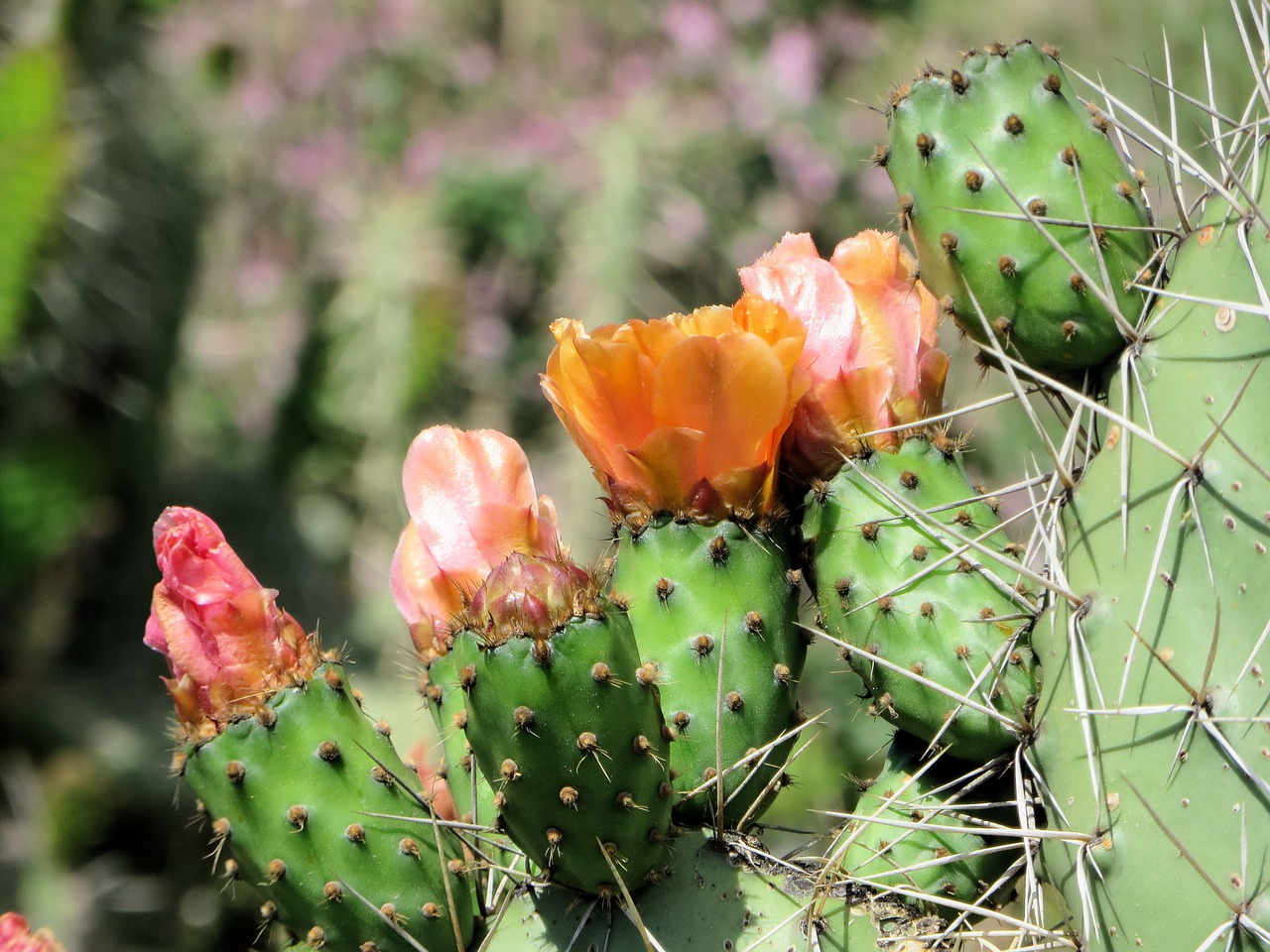
Indian prickly pear flower
How prickly pear cactus reproduces
Culture propagation is carried out in two ways: by seeds and cuttings.
Cactus seeds are bred less often. They, which are in a hard shell, are removed by sawing it. Or the shell is treated with sandpaper, a file so that the seeds can germinate.For sterility, they are kept for 10 minutes in a solution of potassium permanganate, and the soil, consisting of sheet earth, coarse sand and crushed charcoal, is evaporated in the oven.
The pot is covered with foil and placed at a temperature of 20 degrees. Periodically, the film is opened for spraying and removing condensation. When the seeds sprout, they are dived into small containers and kept in good light, but without direct sun exposure. Within 2 years, the sprouts are grown under these conditions, then transplanted into the soil for adult prickly pears.

Prickly pear seeds
The vegetative method is used at any time of the year in a warm room temperature. The stalk is cut from the shoot, dried in an upright position for 1-3 days, until a film forms on the cut. Then they are planted in the ground, pre-calcined in the oven, deepening by 3 cm. For this, a substrate for cacti, sand is suitable. The stalk is placed under the film at a room temperature of 20-22 degrees, the soil is regularly ventilated and moistened, opening the film. After rooting, they are transplanted into the soil for an adult plant.
The stalk may not show signs of growth for a long time, but with the onset of spring and over the summer it quickly transforms into a bush. The cactus will bloom next year.

Propagation of prickly pear by cuttings
Transfer
Young individuals up to 3 years of age are transplanted annually, adults, as needed, every 3-4 years. The plant takes a long time to adapt to new soil. The optimal time for transplanting is spring, before active growth begins, if there are no buds on the plant.
When the cactus has ceased to fit in the pot, the old pot is transplanted from the old soil into the dry soil of the new one. The container is kept in a dark place in the house for a couple of weeks. The first moistening of the soil is in a week. It should consist of sod and leafy soil, sand, clay, expanded clay and crushed charcoal (broken brick).
Possible growing problems and diseases
Ticks, aphids, whitefly larvae, scale insects and mealybugs sucking plant sap are pests. The fight against them is carried out by spraying with a soapy solution, a solution of "Acaricide", excluding contact with the soil. After 7-10 days, the treatment is repeated.
Root nematodes form bulges on the roots. They must be cut to a healthy tissue, the roots are immersed in hot water for 45-50 degrees for 10 minutes, leaving the root collar dry. After that, the roots should be dried, treated with crushed charcoal and planted in fresh sterilized soil.
The most common disease is stem rot, which appears as soft brown spots. The affected area is cut off, the soil is treated with "Carbendazim". Root rot and late blight are formed when infected with a fungus due to regular waterlogging, overfeeding with nitrogen. The affected areas must be removed, treated with a fungicide.
If the leaves wrinkle, these are signs of waterlogging, insufficient lighting. A slowdown in growth indicates excess moisture, lack of fertilizers in the soil.
Signs and superstitions associated with prickly pear
Thorny cacti have long been used in the fight against intruders, placing them on window sills or at the door. A robber or thief had to run into thorns and abandon his evil designs. Later, this superstition was entrenched in prickly pear as a protector from sorcerers, evil eye and corruption.
Opuntia in home floriculture is valued most of all for the unique beauty and variety of its inflorescences.In order for the culture to bloom, it is worth trying and creating all the necessary conditions for this, especially since its unpretentiousness will not require exorbitant efforts.
